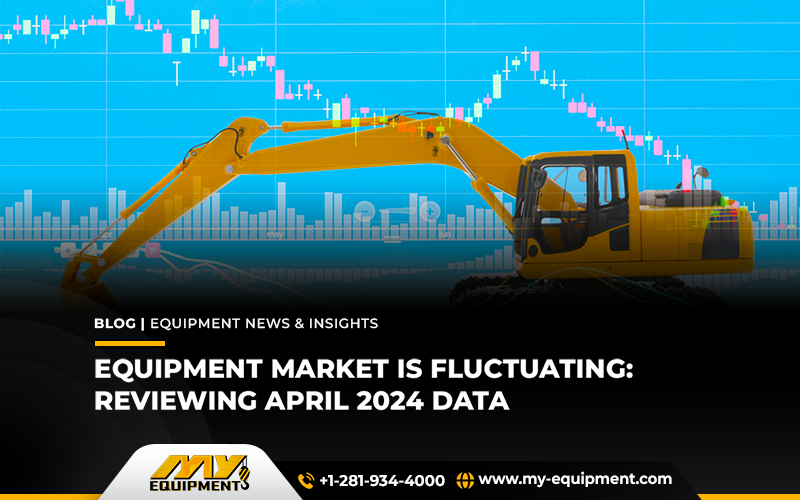The construction industry, along with the equipment market, is already buzzing and in unpredictable situations due to certain reasons. Unparalleled changes are already occurring in the construction equipment industry, which has important consequences for both dealers and consumers. One important indicator of the market’s condition is the difference between retail and auction prices. Retail prices typically indicate a healthy market situation when they closely match auction prices. However, data from April 2024 indicates that there is an exceptionally wide disparity between these values.
Market Imbalance Between Auction and Retail Prices
The market reached its peak in 2022, which led to high values and robust demand. The market has seen that the retail prices increased in parallel with the sharp rise in auction values. This tight alignment implied that supply and demand were in a perfectly balanced market. When we fast-forward to the present, the situation is very different. There is a historically significant disparity of about 30% in major equipment categories since auction values are declining far more quickly than retail values. A possible fizz in retail values is indicated by this growing disparity and over the next 12 to 18 months, clear and sharp declines are expected.
Late Model Stock Piling Up
A further significant feature of the current market environment is the increase in late model inventory, especially for equipment like skid steers and excavators with a 5–7-year age range. The recent dynamics of the market can be linked to this increase. Prices were expensive and equipment was hard to come by during the pandemic’s peak. Many owners decided to keep their machines longer, even though they would normally trade them in or sell them after a few years. Due to their inability to acquire new equipment, rental companies also prolonged the life of their current fleets.
Consequently, late-model equipment is abundant on the market that was held onto for longer than normal. Due to this very reason, there is a backlog that is about twice as large as it was before COVID, with a large amount of inventory aged between five and ten years. As owners upgrade to new units, this flood is now entering the market and further overloading it. This situation is now worrying a small equipment trader whereas the big fleets will also face the consequences eventually.
Warning Signs from Large Manufacturers
Red flags are also being raised by the inventory levels of leading manufacturers, such as Deere, Bobcat, and Caterpillar. Since the 2022 market top, Deere and Bobcat have both experienced significant increases in inventories. But the most alarming news comes from Caterpillar (CAT). CAT is one of the biggest manufacturers of construction equipment in the world, so its inventory management strategies have a big impact on the market.
CAT has been dumping a lot of equipment into its rental fleets over the last four years, which has limited the supply of new equipment and increased costs. This strategy has increased sales of parts and servicing while keeping their rental fleets fully stocked. But for the last six months, CAT has been selling its rental fleet equipment to brokers, wholesalers, and auction houses. Due to the company’s rental fleet plan, there will be an excess of equipment available on the market during the next four to six months, with a projected 50% rise in units.
Since the market’s high in 2022, both Deere and Bobcats’ inventory levels have significantly increased as compared to pre-COVID periods. Deere’s inventory has increased by 40%, while Bobcat’s has increased by 35%.
How Will This Impact the Retail and Auction Values?
Auction values are likely to drop even further when a significant amount of equipment is put up for sale. Retail values will probably decline significantly as a result of this inflow as well, given the current trend where retail values mirror auction trends. The market for construction equipment could see a collapse in auction values soon, which would drive down retail costs. Though, it is still an uncertain statement to put forward as the construction equipment industry has a record to turn the table at any time. However, the experts still suggest that dealers make their strategy now to sustain in the future.
Urge To Make a Strategy Now and Plan for the Future
The state of the market demands that dealers and equipment owners take quick action. Keeping inventory on hand in the expectation of a market recovery could lead to significant losses if values keep falling. To shift older inventory, it is even critical to reassess pricing tactics and consider more aggressive possibilities.
Wrapping Up
Recently, a wave of major challenges confronted the construction equipment sector, including wide discrepancies between retail and auction values, a high percentage of late-model inventories, and warning signs from key manufacturers. Understanding these patterns and taking quick action can help reduce risks and take advantage of opportunities. Dealers may successfully sustain themselves in this unpredictable market and set themselves up for future success by staying updated and making the most of their resources.
In search of a reliable partner in this uncertain equipment market? Look no further than MY Equipment. We are based in Houston, Texas and are experts in buying and selling used equipment. Get in touch with us right now to find out how MY Equipment can assist you in optimizing your equipment inventory.


 1400 Broadfield Blvd, Houston, TX 77084,
USA.
1400 Broadfield Blvd, Houston, TX 77084,
USA. omer@my-equipment.com
omer@my-equipment.com